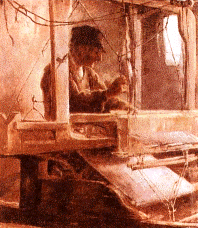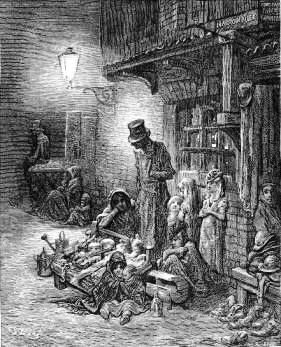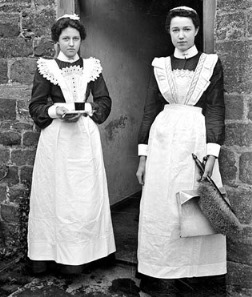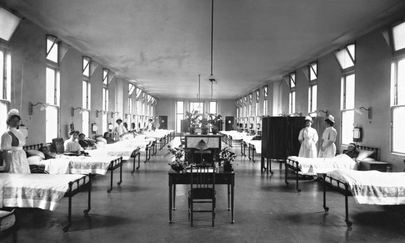isaac malandain + jane middleton

Isaac was born on 30 April 1794 and baptised at St Matthew in Bethnal Green on 25 May; he was the son of Isaac Malandain and his wife Marie Fage. There is no birthplace or adobe listed on the early baptism records but it appears that the family lived in the parish of St Matthew as seven of their eight children were baptised there. Isaac was the third in his direct line to bear this name but although spelling variations began to appear in records relating to his father, siblings and cousins, those relating to Isaac continued to reflect the original spelling.
Isaac carried on another family tradition when he began working as a Silk Weaver despite the economic hardships most worked under at that time. When he was nineteen, his father died and five years later he lost his mother as well. On 24 August 1819, Isaac and Jane Middleton were married by banns at his local parish church, St Matthew, with William Middleton and John Findley acting as witnesses. Little is known of Jane or her family but based on the age on her death record, only one possible baptism record has been found: on 8 March 1795, a Jane Middleton, the daughter of William and Alice, was baptised at the Stratford Congregational Church in West Ham, Essex. But there are no other records to confirm that this is the same person and with this uncertainty, it is difficult to trace her line with any confidence.
Links to the Middleton family
Isaac’s link to the Middleton family began when his older sister Ann married William Middleton at St Mary, Whitechapel on 29 May 1808. The early marriage records do not record the father’s name or occupation so it is difficult to determine how William and Jane were related but other online trees have established a link as siblings and the children of William Middleton and Alice Morton. They cite a marriage between William and Alice at St Mary, Whitechapel in 1788 and a baptism for their son William at St John, Hackney in 1790 in addition to the non-conformist baptism for Jane.
They also list a possible burial record at St Matthew for Ann Malandain in 1812 and a second marriage for William to Elizabeth Daffron at St John, Hackney in 1814 with Jane Middleton acting as one of the witnesses. William and Elizabeth had five children who were all baptised at St Matthew: Martha, Mary, Charlotte, William and Alice. Over the years, records list William’s occupation as a Garderner, a Clerk with the East India Company, a School Master, Bookseller and finally back to a Gardener. In 1841, William and Elizabeth were living on Tryons Place along with their two youngest children William and Alice as well as six year old Isabella Malandain which proves to be a crucial link between the families but more research is required to confirm the wider Middleton family and the exact relationship between Jane and William.
Isaac and Jane had three children and their first, Isaac, was born on 22 June 1821 at the family home on Sclater Street but he was not baptised until 15 July 1829 at St Matthew. Mary was born on 9 June 1826 on Sclater Street but like her brother she was not baptised as an infant but as an eight year old on 22 June 1834 at St Matthew. Isabella was born on 29 October 1835 on Sclater Street and baptised on 15 January 1836 at St Matthew.
On 15 August 1837, tragedy struck the family when 42 year old Jane died at 26 Sclater Street of typhus fever. She was buried at the Gibraltar Row Burial Ground on 20 August and only two weeks later, Isaac also died of typhus at the family home with his brother William acting as the informant. On 8 September, Isaac was also buried at Gibraltar Row leaving three orphaned children: Isaac 16, Mary 11 and Isabella only 2 years.

Typhus is a bacterial infection that is transmitted to humans through bites by infected fleas or lice and results in flu like symptoms but it was not identified as a distinct infection until 1847. Until that time, typhus was used as a general term for any illness with symptoms consisting of a high fever, vomitting and diarrhea such as influenza, typhoid, and paratyphoid — all epidemic type illnesses that flourised in overcrowded and unsanitary conditions. Even if the family could afford a physician, the diagnostic tests to identify the exact cause of the illness did not exist nor did the treatment as the first antibiotic, penicillin, was not discovered until 1928.
Later records indicate that Isaac and Jane’s children were taken in by various family members. In 1841, their son Isaac was living with James and Mary Fage and their six children in Wellington Row, Bethnal Green and working with James as an Apprentice Weaver. From initial research, it appears that James Fage and Isaac, the elder, were cousins.
Their middle daughter Mary has not been found in 1841 although there are several possible matches for her as a female servant — one lists a 15 year old Mary Malandine on Gun Street in Spitalfields working for Rebecca Turner, a 65 year old Weaveress, and the second is living with the Batty family in Tyssen Cottages in St John Hackney. Six year old Isabella was living with William Middleton, his wife Elizabeth and their two children at Tryons Place in South Hackney and although it has not been confirmed, William is believed to be Jane’s brother.
On 5 May 1845, Isaac married Elizabeth Frederick, the first of his three wives, at St Philip in Bethnal Green and although his family may have attended, none were listed on the register as witnesses. He had served out his seven year apprenticeship with James Fage and was still working as a Weaver.
In 1851, Mary was working as a domestic servant for Charles and Clara Cheesewright at their home at 5 Cambridge Place in St Pancras. Ten years later, she was living at 1 Lower Hill, Martins Villas in Islington where she worked as a servant for Thomas Challis, a Hide and Skin Salesman, and his family. She was still working for the family in 1871 although they had moved house to North Hill in Highgate.
At the age of 46, Mary married widower George Forrester Kinnerly at the Baptist Chapel in Highgate on 4 December 1872. No occupation was listed for her on the marriage certificate but she was still living at North Hill and likely worked for the Challis family up until her wedding. George was born on 10 May 1831 to Samuel Edward and Sarah Kinnerly and worked as a Shoemaker for most of his life. In 1854, he married Jane Elizabeth Davey at St John the Baptist in Hoxton and they had three children; the family was living in the Coleridge Buildings on Archway Road in Highgate which was not far from Mary’s home on North Hill. Jane died of consumption at the family home on 22 April 1872 and with two children under the age of 10, George chose to remarry within the year.

But only three years after their marriage, George died and with no other means of support, Mary was forced to return to work as a domestic servant but she was fortunate enough to find a position with an employer who allowed her to bring her young step-daughter, Elizabeth. In 1881, she was working as a housekeeper for Arthur Smither, a 39 year old Actuary, at Netley Cottage, The Grove in Hampstead. By 1891, sixty-four year old Mary was still working as a housekkeeper but had moved on to a new employer, 63 year old Steam Engine Driver, Thomas Moore at 5 Union Street in Islington. Her step-daughter was working as a House Maid in the home of Charles Bruce and his sister Mary at 12 Marble Arch in Marylebone.
In 1901, Mary was a visitor in the household of James and Amy Dix at 44 Wood Lane in Hornsey and although she was no longer able to work as a domestic servant, she was doing some piece work as a Needlewoman. The relationship between Mary and the Dix family is not known but Amy was born in East London in 1838 so they may have been childhood friends. In 1911, Mary and her 43 year old step-daughter were living together in the Wollaston and Pauncefort Almshouses at 29 Southwood Lane in Highgate and Mary was listed as a pensioner while Elizabeth had no occupation. The almshouses, still in operation today as sheltered accommodation, date back to 1658 when they were built by Sir John Wollaston ‘for the use of six poor alms people men and women, of honest life and conversation, inhabitants of Hornsey and Highgate’ but they were torn down and twelve rebuilt in their place in 1722 along with a girl’s charity school. Mary died in Edmonton in 1913 and was buried at Camden Cemetery on 24 November; her step-daughter died in Wood Green, Haringey in 1951.
Isaac and Jane’s youngest daughter, Isabella, was only 2 years old when her mother and father died and she spent the next five years living with William Middleton and his family before being admitted to the French Protestant School for girls. The school opened in 1747 and occupied several sites including the Savoy Chapel and Spring Gardens before a permanent location was built next to the new French Protestant Church in Bloomsbury in 1845. The records in the Proceedings of the Huguenot Society Vol. IV provides a summary of the education provided:
In it the little girls are housed, fed, clothed, and educated gratuitously. Particular attention is paid to their French pronunciation, so that they may do their duty in the adjoining French Church creditably. The education given is a simple elementary one corresponding to their station in life — and a certain number are told off each week to assist in the household work in order to qualify them for servant’s places when they grow up. Even if the accommodation in the School house would admit of more than fifteen girls being received, the funds of the charity would not suffice for its extension to a larger number.
The records do not list the dates of her attendance at the school but students could not be admitted until they were 7 and had to leave when they were fourteen so Isabella likely left the school in 1849 and either returned to the Middletons or went straight into service. William Middleton was widowed in 1848 and when the census was taken three years later, he was living alone and working as a Tea Warehouseman in St George in the East but there is a possible match for Isabella Ballandine working as a house servant for Elizabeth Lucas at 17 Retreat Place in Hackney. On 11 January 1852, illness forced Isabella to apply for relief from the Shoreditch Board of Guardians and her application notes that she had been in service at 23 New North Street off Curtain Road for 5 weeks and before that she was in service at 17 Warner Place in Hackney. Isabella’s uncle, William Mallandine, lived on South Conduit Street and provided the Guardians with confirmation that she was born in the area and therefore entitled to relief. A note in the margin reads ‘temporarily sick, bad cold, mistress will take her back when well’ so it appears that Isabella was too sick to work and as a result her employer sent her away but she may have agreed to take her back after being contacted by the Guardians.

It is not known if Isabella returned to New North Street but by 1861, she had moved on to a new employer, Alfred Ellen, a Clerk to a Tea Merchant who lived at 3 Caroline Cottages on St Ann’s Road in Vauxhall south of the Thames. Isabella died of pulmonary tuberculosis on 23 December 1866 at Fort Pitt in Rochester, Kent and James Groves acted as the informant on the death certificate. No address other than Fort Pitt was listed and her occupation was given as Gentlewoman which usually indicated that the individual did not work. Fort Pitt was a military fort built in the early part of the 19th century but less than twenty years later, the military installation was removed and it was converted to hospital for invalided soldiers, an asylum and finally the first site of the Army Medical School in 1860.
Isabella may have moved to Fort Pitt to be closer to her brother Isaac who had joined the army and was posted to Rochester in 1864 - 65. She may have been unable to work as a result of her illness and may have had the offer of medical treatment through Isaac’s connection to the army and in particular the Army Medical Corps. With no other ties to the area, it seems likely that her decision to move to Fort Pitt was based on her relationship with her brother and this is the only indication that the siblings maintained contact after their parents’ death.